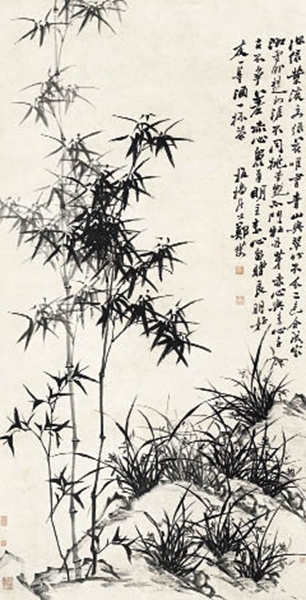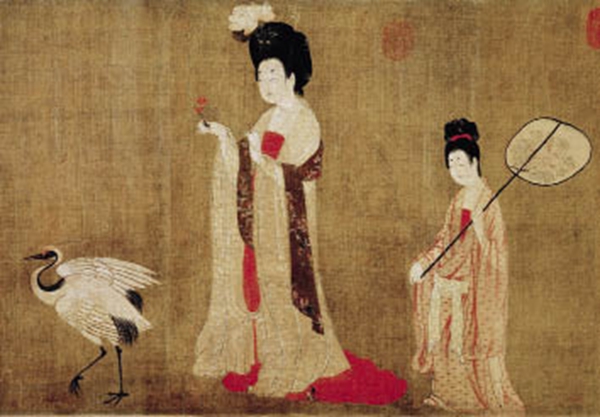By GU HE
THE earliest Chinese paintings appeared about 4,700 years ago. The patterns and designs on clothes and utensils, including pottery, during the Shang and Zhou dynasties (c. 1600-256 BC), are testament to the existence of paintings of landscapes, figures, birds and animals.
During the Han Dynasty (206 BC - AD 220), artists mainly painted human figures, such as loyal court officials, filial sons, or treacherous subjects and unfilial sons, so promoting good and punishing evil. However, the figure paintings of that period lacked refinement in terms of painting techniques.
During the Six Dynasties period (220-581), figure painting improved with the emergence of such master painters as Gu Kaizhi (348-409). The Northern Qi (550-577) artist Cao Zhongda created a style best known for the overlapping and form-fitting clothes his figures wore that tightly followed the contours of the body as if drenched in water. Wu Daozi (680-759), an erudite painter of the Tang Dynasty, created a natural and lively style, with figures wearing floating robes as if blown by wind. Those two styles have remained influential until today. The human figures painted during that period have plump and square faces. One work evincing this feature is Court Ladies Wearing Flowered Headdresses, attributed to Zhou Fang (c. 730-800). By the Ming Dynasty (1368-1644), the figures in Chinese paintings had more beautifully depicted faces.

Bamboo by Zheng Banqiao, one of the eight flower and bird painters of the Qing Dynasty, known as the “Eight Eccentrics of Yangzhou.”
Landscape paintings originated during the Six Dynasties period, when they mainly served as background for human figures. This genre reached its zenith by the Tang Dynasty thanks to such painters as Li Sixun (651-716). In fact, all members of the Li family were painters. They practiced detailed brushstrokes and boldly used gold and dark green colors to capture the ambience of the prosperous Tang Dynasty. After the rebellion led by An Lushan and Shi Siming (755-763) artists such as Wang Wei (701-761) created a genre characterized by strong brushstrokes contrasted with light ink-washes. Such styles were passed on and further developed by Su Dongpo (1037-1101) in the Northern Song Dynasty. Su once remarked, there are paintings within Wang’s poems, and poems within his paintings. Most landscape painters from the second half of the Tang Dynasty to the end of the Northern Song Dynasty followed Wang’s style. This also explains why the Chinese painting style is often called ink-wash painting. Moreover, there were many master painters who excelled in painting horses during the Tang Dynasty.
The bird-and-flower painting first emerged in the 10th century, and flourished by the Song Dynasty (960-1279). Scholar-artists in the Song led relatively affluent lives and took to painting figures, birds or flowers as form of recreation. Paintings of plum blossom and bamboo are typical of the Song Dynasty. In the Xuanhe Collection of Paintings, a book on paintings collected by the imperial palace, compiled during the Xuanhe reign of the Northern Song Dynasty, ink paintings of bamboo are listed as a discrete category.

Part of the Court Ladies Wearing Flowered Headdresses, a famous figure painting of the Tang Dynasty.
The Song court also set up the Imperial Painting Academy to enroll painters around the country, granting them official positions according to talent. The Academy often offered poetic concepts, which the painters were invited to express in their compositions. For example, the painting that best expressed the poem: “Treading flowers on returning home, horse hooves fragrant” – depicts a group of butterflies fluttering around the hooves of a trotting horse.
There emerged many famous artists and various schools during the Song Dynasty, including Fan Kuan (950-1032), Mi Fu (1051-1107), and Zhang Zeduan (1085-1145). Qingming Festival at the Riverside by Zhang Zeduan is a masterpiece known to the world for its vivid depiction of scenery and people. As an exquisite representation of realism, it was displayed at the Palace Museum in Beijing last autumn, attracting as many as 8,000 visitors in just one day. The famous painter Xu Beihong (1895-1953) commented that the Song Dynasty was the most glorious era in the development of Chinese painting.
By the Ming Dynasty (1368-1644), painting academies again entered a phase of flourishing development, in a scale comparable to the Song Dynasty. Figure paintings during the Ming Dynasty were mainly based on folk customs and historical tales. By the Qing Dynasty (1644-1911), artists seldom painted figures, and when painting landscapes most followed styles formed in earlier dynasties. With many schools of flower-and-bird painting in the Qing Dynasty, some innovations were achieved. A group of eight artists during the Qianlong reign rejected orthodox ideas in favor of a style deemed individualist in their flower-and-bird paintings. They became known as the “Eight Eccentrics of Yangzhou.”
Chinese painting is completely different from European painting as it employs different instruments in terms of brushes, ink, rice paper, and ink-stone. The way the brush is used decides that a Chinese painting is composed of strokes and lines, making the paintings as aesthetically pleasing as calligraphy (the art of beautiful writing). The masterful use of the brush results in different expressive possibilities, namely thick and thin, dry and wet, setting the basic tone of the Chinese painting. The emergence of rice (or xuan) paper enabled Chinese painting to achieve a new level of sophistication. What is most special about Chinese paintings is that they are often embellished with a poem, forming a distinctive artistic style merging poetry and painting.
However, there have been various debates in modern times. Xu Beihong points out that Chinese painting has been on the wane in recent times because many artists focus on imitation or duplication rather than innovation. Efforts are needed to explore a new development path for Chinese painting so that it absorbs the best elements of Western art while at the same time maintaining its own style and seeking innovation.
(Selected from Monthly Digest by Zhonghua Book Company)
